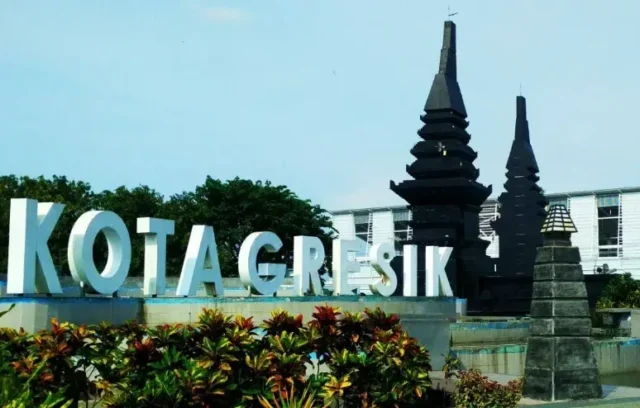About Semarang – Gresik, which is located on the north coast of Java, has a long and rich history, covering various major periods in Indonesian history.
From the influence of Hindu-Buddhism, the entry of Islam, until the colonialism, Gresik has played an important role in the development of culture and trade in East Java.
The development of Hinduism and Buddhism was first recorded in East Java in the 7th century AD, when the Kingdom of Ho-Ling became the center of the spread of Hinduism.
Quoted from Disparekrafbudpora.gresikkab.go.id, During the Majapahit Kingdom, around the 14th century, Gresik was still part of an area that adheres to Hindu-Buddhist religion.
This is evident from the inscription found in Karang Bogem (Trawulan V) in 1387 AD, which mentioned the name Gresik as an area involved in the fisheries industry.
Archaeological evidence found in Gresik shows how important this region is at that time.
Findings such as crossing inscriptions from 1358 Saka and various Dwarapala and Buddhist statues around Bajrapura Village (Mojopuro) are strong evidence of the influence of Hindu-Buddhist.
In addition, Gosari Ujung Pangkah Pottery which is a trading commodity with the Kingdom of Singosari and Majapahit is also found here, proving the role of Gresik as a trade center and a developing port.
On Bawean Island, which is also part of Gresik Regency, found some archeological evidence that showed the influence of Hindu-Buddhist, such as the Archa Mahakala and Stupika Clay, which are important symbols in Hinduism and Buddhism.
Before the arrival of Islam, the majority of the Gresik population adheres to Hindu-Buddhist religion, with some who still embrace animism and dynamism.
The spread of Islam in Gresik began in the 11th century, with the arrival of Sunan Maulana Malik Ibrahim in around 1368 AD Sunan Malik Ibrahim was known as Sheikh Maghribi or Sunan Gresik, who became the key figure in the spread of Islam in Gresik and its surroundings.
The preaching approach carried out by Sunan Malik Ibrahim is very attractive to the attention of the Gresik people, both from the aristocracy and ordinary people.
He not only teaches Islam, but also helps the poor, establishing mosques and pesantren, and trading at affordable prices to help the economy of the local community.
As a wise scholar, he was successfully accepted among the community and was even appointed as Syahbandar (Port Head) by the Majapahit Kingdom.
After the death of Sunan Malik Ibrahim on April 8, 1419 AD, the Islamic struggle in Gresik was continued by other saints, such as Sunan Giri who founded the Kingdom of Giri Kedaton in 1481 AD
Under the leadership of Sunan Giri, Gresik developed into the center of trade and development of Islam in East Java.
Gresik also had a significant colonial history, starting with the arrival of the Portuguese in the early 16th century.
In 1520 AD, the Portuguese fleet led by Antonio de Abreu landed in Gresik, even though they only lived temporarily after a few years leaving the port in 1522 AD
They called Gresik by the name Agaze, who later became Agacime.
In 1598 AD, the Dutch began to enter Gresik, led by Jacob Van Heemskerck, to trade. Gresik became a strategic place for the VOC (Vereenigde Oost-Indische Compagnie) which was founded in 1602 M.
VOC established a trading office in Gresik in 1603 AD and controlled the spice trade at this port.
During the Dutch colonial period, Gresik became the center of oil exploration and weapons production.
As part of the colonial government, Gresik experienced a significant Dutch influence, especially in trade and local government structures.
The Lodewijk Fortress, which was built by Daendels in 1808 AD, functions as a stronghold to dispel British troops.
In 1811 AD, Britain officially took over Gresik as part of their colonial territory after the Tuntang Capitulation Agreement.
In addition to the Lodewijk fort, the flute substation which was built in 1929 has become one of the colonial relics that still exists today.
During the Japanese colonial period, the flute substation was used as a warning of enemy attacks and served as a marker of breaking the fast after independence.
Gresik has played an important role in Indonesian history, from the Hindu-Buddhist era, the spread of Islam by the saints, until the colonialism.
As a port city, Gresik has become a trade center that connects various cultures, ranging from Java, Malay, Arabic, China, to Europe.
The strong influence of Hindu-Buddhist religion in this region gives a solid foundation for the spread of Islam which then changes the face of Gresik into a great center of Islamic da’wah.
The role of Gresik as the center of trade, both during the Hindu-Buddhist kingdom and the colonial period, made it one of the strategic cities in East Java.
The historical heritage in Gresik, such as inscriptions, statues, fortresses, and flute substations, is a silent witness to the city’s long journey in dealing with various cultural and power influences that come and go. ***
News
Berita
News Flash
Blog
Technology
Sports
Sport
Football
Tips
Finance
Berita Terkini
Berita Terbaru
Berita Kekinian
News
Berita Terkini
Olahraga
Pasang Internet Myrepublic
Jasa Import China
Jasa Import Door to Door
